Top 10 Patterns from Lake Champlain
Both species and both ends of the lake produced
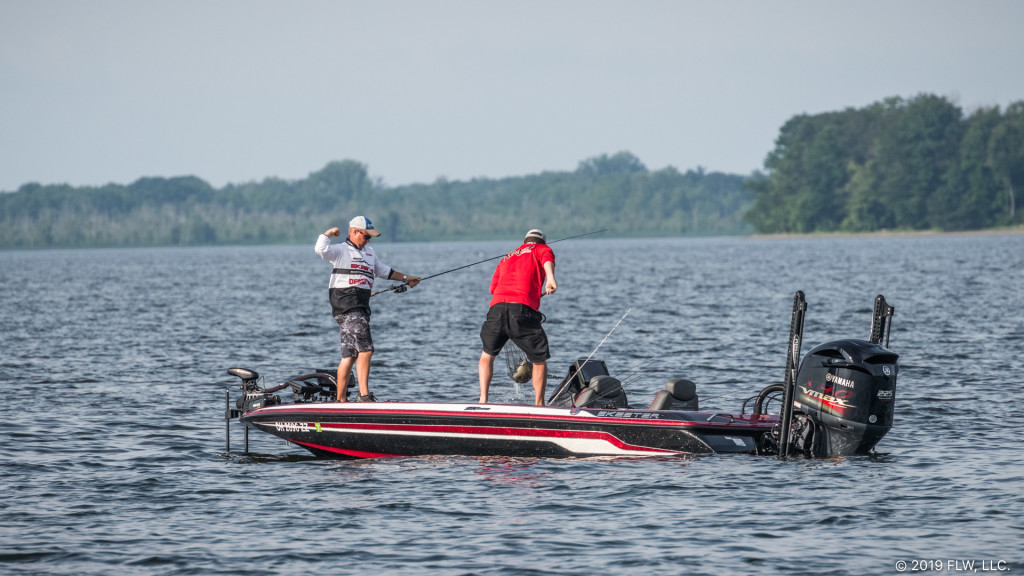
Grueling wind on day two of the Costa FLW Series Northern Division opener on Lake Champlain didn’t do the field any favors, but otherwise, it was a heck of a tournament on the big northern fishery. The aftereffects of an odd spring with high water had things somewhat scrambled, putting some of the local participants on their off foot, but a variety of patterns proved to be successful.
Bryan Thrift earned the win fishing up north, weighing mostly largemouths he plucked from fairly shallow grass. Others made the top 10 solely on smallmouths or by making the run to Ti for their largemouth, but if there was any overarching theme, it was certainly how well the northern green fish played. In fact, six of the top 10 anglers weighed in northern largemouths on at least one of the first two days.
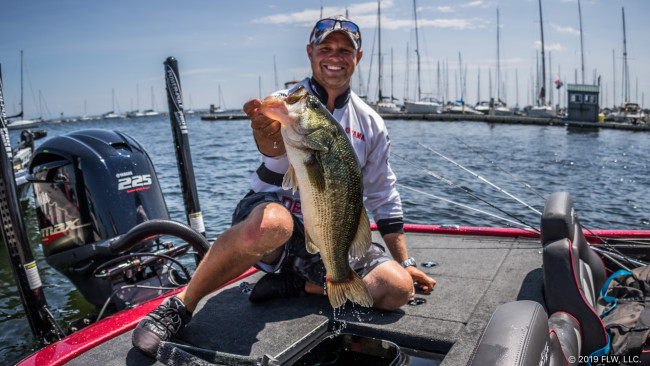
2. Levin adapts perfectly
Edward Levin fished a nearly perfect tournament, and if it’d just been windy on day one, he may have won. Weighing in 18-6 the first day, Levin got knocked off his primary area by the wind on day two and cracked 19 pounds each of the final two days for a 56-9 total.
On day one, Levin fished for smallmouths in the main lake, but he turned to the Inland Sea and a mix of species on subsequent days. For smallmouths, he targeted isolated piles and veins of small rock with a YUM YUMbrella Flash Mob Jr. with Reaction Innovations Skinny Dippers and Little Dippers (in white trash with one perch-colored swimbait).
“Today they wanted it closer to the bottom,” says Levin of his umbrella rig tactics. “The other days I’d burn it a lot higher, a lot faster. They’d come up and hit it. Today they were a little sluggish; there was less wind, and I had to let it actually let it hit the bottom, then jerk it off the bottom and slowly start reeling. That’s when they’d hit it.”
For largemouths, Levin flipped grass with a 3/8-ounce Texas-rigged tube, but he didn’t do it like everyone else.
“I was flipping grass in about 12 to 15 feet of water,” says Levin. “Just isolated patches where milfoil would mix in with other grass and some rock. It’d stick up to about 5 or 6 feet under the water. You had to graph it to find it. So, to be honest, I had it to myself all week
“There were big schools of largemouth in there. We’d run through 30 or 40 keepers a day to get those 3 1/2- and 4-pounders.”
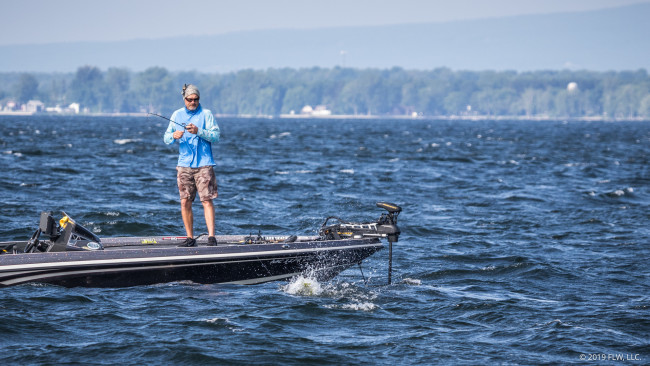
3. Dobson leans on smallies
Scott Dobson and smallmouths go together like chocolate and peanut butter, so it was no surprise to see him earn another top 10 with brown fish. The Michigan angler ended up with only 15-9 on the final day, which took him out of the running for a win, but he was the highest-finishing angler in the field to weigh in all smallies.
Dobson mostly relied on a few stretches offshore near Rouses Point. He mixed baits profusely, and weighed fish on a few jerkbaits, a pencil popper, a spy bait and a drop-shot.
“I just didn’t get many big, key bites today,” says Dobson. “The fish were there, but today, nothing was happening. We were catching fish, but you can’t put that drop-shot in front of enough fish to get the big bites. That’s why they need to eat that jerkbait, so you can cover water and get those big bites.”
As is often the case with smallies, Dobson lost quite a few each day as well. However, he was getting enough bites the first two days to make up for it. Though he fished a long stretch of offshore grass every day, he ended up weighing in a lot of his fish off one small area along it that had leaner bottom and very sparse cabbage.
“You can’t win unless you make the top 10,” says Dobson, who’s now got a good start to a possible Angler of the Year run. “If I would have stumbled yesterday, I’d have come in 30th place. So, I’ll take my check and go home.”
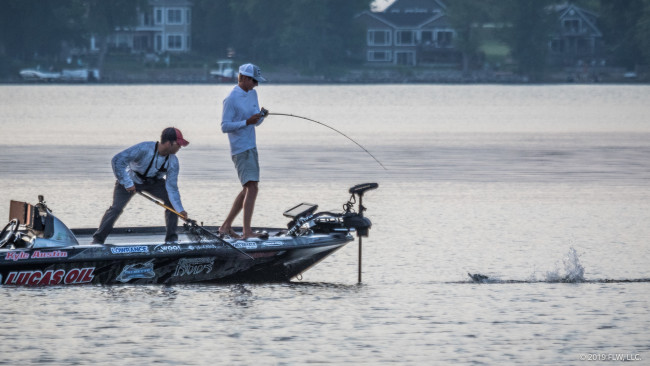
4. Tumberg struggles to follow up on day one success
Brandt Tumberg hammered out 21-10 worth of largemouths on day one, but he hovered around 15 pounds the rest of the way.
Fishing up north in The Gut and the Inland Sea the whole time, Tumberg had a school of largemouth on a shallow point dialed in, as well as some flipping fish in mats. On day one, they both paid off in a big way, but he never got to fish his mats on day two and had to rely solely on his point. On the final day, the bigger bites just never came.
In addition to flipping and throwing a topwater, Tumberg also caught a bunch of fish off the shallow point with finesse tactics. A watermelon-colored Zoom Trick Worm on either a shaky head or a Neko rig did the trick for that.
Though he couldn’t follow up day one, his only regret is not spending less time on smallmouths.
“I would have not gone smallmouth fishing if I could do it again,” says Tumberg. “I caught some good ones in practice and spent a lot of time on them. That was a waste. In the tournament I was never able to catch any.”
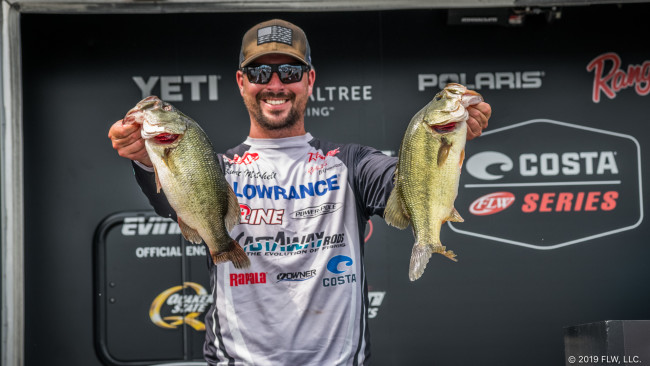
5. Mitchell goes north and south
A stupendous practice and a world of confidence in Ticonderoga bode well for Kurt Mitchell in his latest attempt at Champlain. It didn’t really turn out as planned, but the Delaware FLW Tour pro still managed to wrangle up enough to finish fifth.
Mitchell ran south to Ti on days one and three, but he stayed up north because of the wind on day two for his biggest bag of the event.
“Even that didn’t go as planned,” says Mitchell. “I went up into the Missisquoi River and started fishing log jams. There are two main trees in there that are big and have a lot of jam in them. In practice I was catching them on creek mouths in the river; you could just catch them every cast, but the water dropped in there and that was done. I knew the log jams out in deeper water were still going to have the fish on them — that’s the only place they could have been.”
After making the cut, he decided to run back down to Ti.
“I knew that I needed 22 pounds or something to win and catch up to Thrift,” says Mitchell. “To me, Ti was the only place that I could do that. I didn’t really have the opportunity today. I lost two big ones, but in Ti, if everything works out perfect, you can come in with 22 pounds.”
Down at Ti, he didn’t do anything too special. Some hard cover and some grass places produced the bulk of his fish.
“You had to find grass with bait in it,” says Mitchell. “The alewives would be flickering in some of the grass mats, and those were the mats you had to find. When you found them schooling up and busting on them it didn’t matter what you threw at them, but for the most part, you had to throw a white frog to get bit and then follow it up with something flipped in there.”
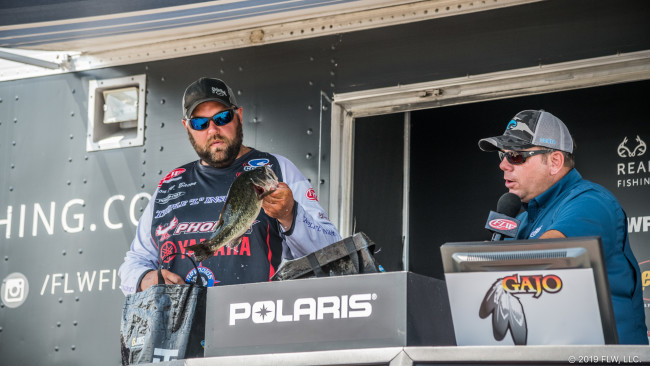
6. Bacon mixes green and brown
Fishing north each day, Jason Bacon caught a mix of largemouths and smallmouths. On day two, he weighed in 19-1 to vault into the cut, but couldn’t make it happen again.
“The first day, I caught most of my better fish flipping mats,” says Bacon. “The second day, I caught a bunch on a Ned rig in the morning on current, and my better fish came on a jig. It was a mixture of hard cover, docks, and some rock piles and stuff like that. Most of it was in 2 to 4 feet.”
Bacon targeted current at the breaks in causeways, but stayed on the deeper side, in 12 to 16 feet of water. He ran the same game plan of current and targets on day three, but could only scrounge up 15-15.
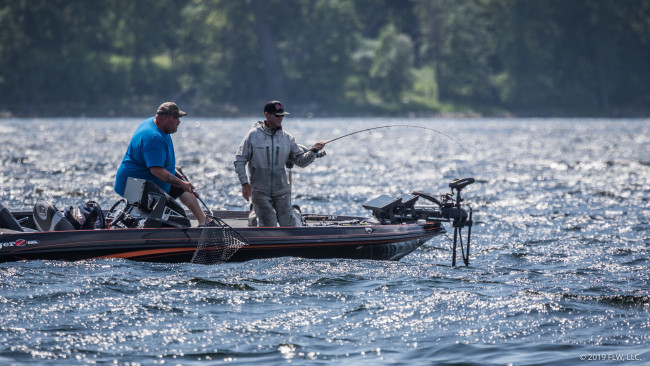
7. Smallies are the ticket for Vaughan
The second of three pros to weigh in entirely smallmouths in the top 10, Wayne Vaughan tallied 19-5 on day one, but couldn’t quite break the 16-pound barrier thereafter.
Fishing through the Inland Sea and near Rouses Point on day one, he committed to fishing about a mile away from Scott Dobson on days two and three.
“I knew there was a fair amount of fish in that area,” says Vaughan. “Everything else I had was more spread out, so I just went ahead and committed to that area.”
Like Dobson, Vaughan had a little sweet spot that he developed as the tournament went on.
“Most of it was between 11 to 14 foot, and it has a crazy mixture of grass depending on what part you’re in,” says Vaughan of the area. “What I figured out with it is there’s a really clean section that is in the middle. Sometimes they wanted to get up in the clean section, and sometimes they nestled out in the grass.”
Vaughan put a drop-shot with a wacky-rigged 4-inch Yamamoto Senko to work for the most part. He also added in a Ned rig, a tube and a shad-colored Megabass Vision 110 jerkbait.
“I threw a Ned rig a lot on day two, like a heavy Ned rig,” says Vaughan. “I found out I could take a tube and rip it out of the grass, but then all of a sudden they got weird and wouldn’t bite it. But I had a bunch of crawdads in my livewell, so I put a little Ned rig on and I caught a fair amount of fish on that.”
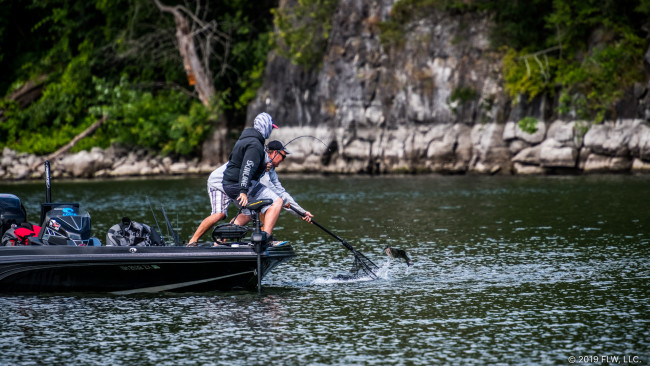
8. Wood goes green
Running to Ti each of the first two days paid off with a top 10 for Joe Wood, but he elected to fish up north on the final day. In practice, Wood located a massive school in the grass at Ti, but that was gone during the tournament, and in two days of trying he couldn’t relocate it.
“It was actually a really good week. I can’t complain,” says Wood, who’s won a Northern Division AOY title before. “Just making a top 10 here is hard to do.”
In Ti, Wood didn’t do anything too fancy when he wasn’t’ trying to relocate his school.
“I pretty much just junk-fished down there,” says Wood. “I fished a little grass, I fished some laydowns, I fished a few docks and some cribs. I just did a little of everything.
“I just never got the same bites I got down there the first day,” says Wood of the call to try north. “And I looked at the weather forecast, and it wasn’t blowing too hard at takeoff, but the app I had on my phone said it was gonna blow out of the south at 15, and I didn’t want that.”
On the final day, Wood nabbed a quick limit of smallmouths and then culled most of the flipping in The Gut, but he never ran into quality fish.
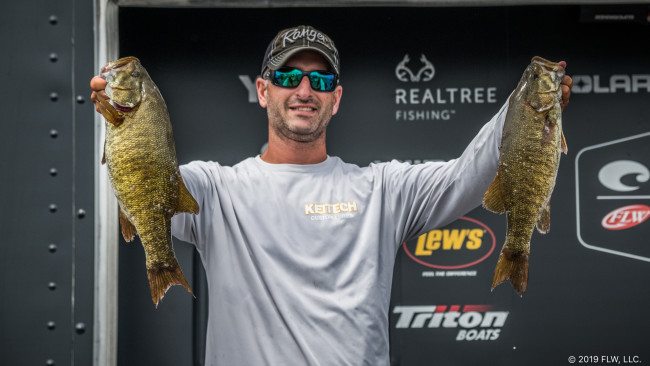
9. Smallmouths help Smith start the season strong
Northern Division stalwart Casey Smith plucked limits of smallies each day for a strong start. Lost fish and some mechanical difficulties cost him on the final day, but he still tallied a more-than-respectable finish.
“Practice was really good all the way through,” says Smith. “I found them shallow early in practice and then in 15- to 20-feet as the week went on. I fished both on day one, and I started deep and then went to the shallow stuff and upgraded. Day two I ran the shallow stuff right from the get-go, and I focused on the most windblown places I could find.”
Running shallower places on the final day was the ticket as well, though his landing ratio went down. His shallow areas were mostly mixes of rock, grass and sand in anywhere from 6 to 12 feet of water. For baits, he used a Lucky Craft Slender Pointer 112, a 3.3-inch Keitech Swing Impact FAT and a Duo Realis Spinbait 80 in either grass minnow or ayu.
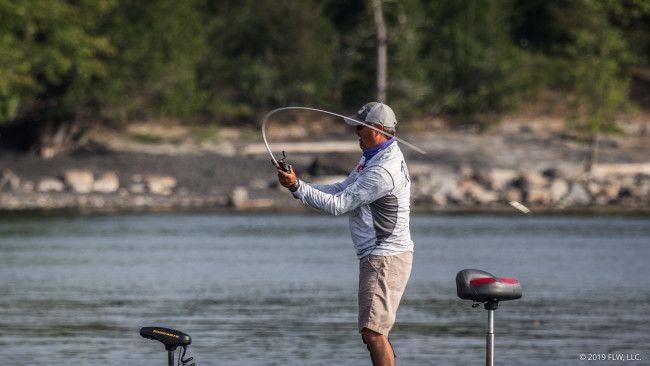
10. Nelson takes a crack at three in a row
The winner of the two previous Costa FLW Series events on Champlain, Ron Nelson got into this one at the last minute on a bit of a whim and turned in another great finish.
Nelson mixed largemouth and smallmouth, but the bulk of his weight came from a pair of humps near deep water in close proximity to each other that had a big school of smallmouth on them.
“The biggest key was finding that group of fish,” says Nelson. “I left them biting on the first day; I didn’t want to beat them up. It was a megaschool that was deep, and they would pull up on the shelf and eat a topwater.”
A topwater, a jerkbait and a drop-shot were the deal for Nelson’s smallies, but he mostly lost them on the final day.
“I don’t know why the fish weren’t really committing today,” says Nelson. “You had to slow down and spoon-feed them, and they’d still not get it. I was just barely poking them, and then they’d turn and come free.”
Nelson also flipped a few largemouth in Carry Bay, and but he never really got in the hunt for a third consecutive win.
“The overall event was good,” says Nelson. “The fish were biting good and they were healthy. I feel really blessed to have two wins here, and I feel blessed to make the top 10.”